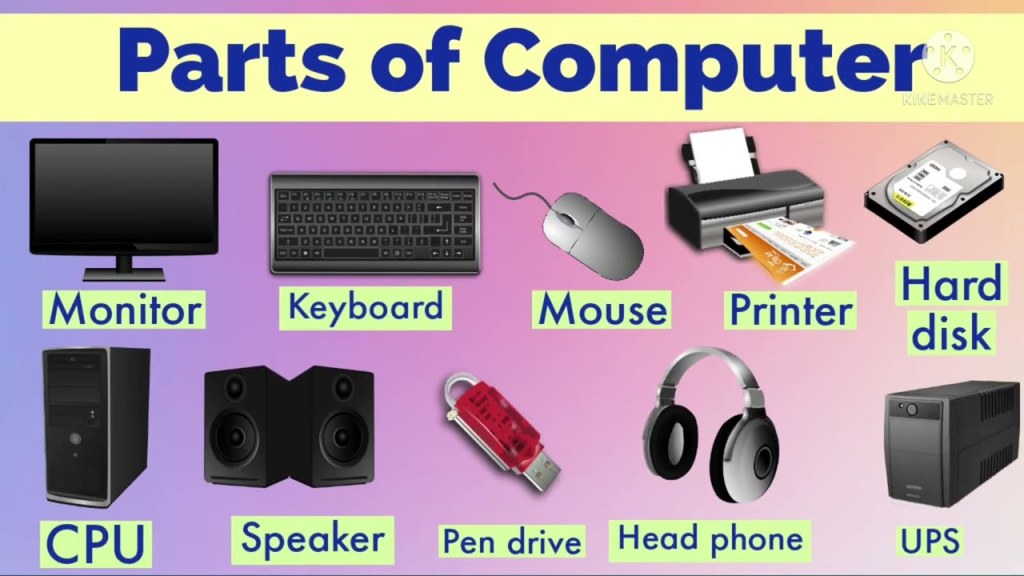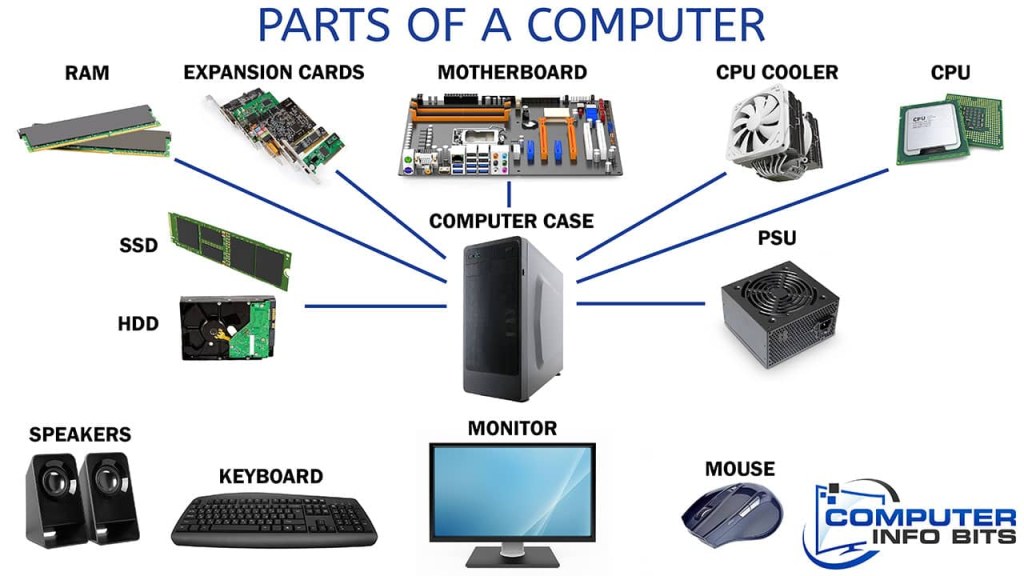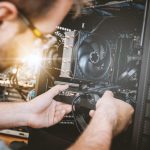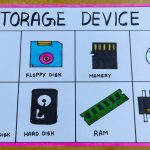Unlock The Power Of Computers: Discover The Essential 5 Parts Name Now!
Computer 5 Parts Name: A Comprehensive Guide
Greetings, Readers! In this article, we will delve into the world of computers and explore the five essential parts that make them function seamlessly. Computers have become an integral part of our daily lives, and understanding their components will not only enhance our knowledge but also enable us to make informed decisions when purchasing or troubleshooting these devices. So, let’s dive in!
Introduction
2 Picture Gallery: Unlock The Power Of Computers: Discover The Essential 5 Parts Name Now!


Computers consist of several components that work together to provide us with the functionalities we rely on. Understanding these components is crucial for anyone who wants to have a grasp on how computers operate. In this section, we will provide a comprehensive overview of the five main parts of a computer, their functions, and their importance in ensuring smooth operations.
Central Processing Unit (CPU) 🔍
The CPU, often referred to as the brain of the computer, is responsible for executing and managing all instructions and calculations. It is the component where most of the actual processing takes place. Without a powerful and efficient CPU, a computer would struggle to perform even the simplest tasks.
Random Access Memory (RAM) 💾

Image Source: ytimg.com
RAM serves as the computer’s short-term memory, allowing it to store and quickly access data that is currently in use. The more RAM a computer has, the more information it can handle simultaneously, resulting in better multitasking capabilities and faster overall performance.
Hard Disk Drive (HDD) 💽
The HDD is where the computer stores all its data in a non-volatile manner. It provides long-term storage for the operating system, software applications, and personal files. The size of the HDD determines the amount of data that can be stored, making it an essential consideration when purchasing a computer.
Motherboard 🖥️

Image Source: computerinfobits.com
The motherboard acts as the central hub that connects all the different components of a computer. It provides the necessary communication channels for data transfer between the CPU, RAM, storage devices, and other peripherals. It also houses important connectors and ports for external devices, such as USB and HDMI ports.
Graphics Processing Unit (GPU) 🎮
The GPU is responsible for rendering and displaying visual content on the computer’s monitor. It is especially crucial for tasks that require intense graphical processing, such as gaming, video editing, and 3D modeling. A high-performance GPU can significantly enhance the visual experience and overall speed of these applications.
What is a Computer?
A computer is an electronic device that processes and stores data. It can perform various tasks, ranging from simple calculations to complex simulations. Computers come in different forms, such as desktops, laptops, and tablets, but they all share the same fundamental components that allow them to function effectively.
Who Invented the Computer?
The invention of the computer cannot be attributed to a single person. It is the result of centuries of progress and contributions from countless individuals. However, one of the key figures in the development of computers is Charles Babbage, who is often referred to as the father of the computer. His designs for mechanical computing machines laid the foundation for modern computers.
When Were Computers Invented?
The concept of computers can be traced back to ancient times when humans used various tools and machines to perform calculations. However, the first electronic computer, known as the Electronic Numerical Integrator and Computer (ENIAC), was built in the 1940s. Since then, computers have evolved significantly, becoming smaller, faster, and more powerful with each passing year.
Where are Computers Used?
Computers are used in almost every aspect of our lives, from personal use to business applications. They are found in homes, offices, schools, hospitals, banks, and even in outer space. With the advent of smartphones and other mobile devices, computers have become even more pervasive, enabling us to stay connected and productive on the go.
Why are Computers Important?
Computers play a vital role in modern society for several reasons. They facilitate communication, streamline processes, store and analyze vast amounts of data, and enable us to access information from around the world. Computers have revolutionized industries, such as healthcare, finance, and entertainment, making tasks more efficient and opening up new possibilities.
How Do Computers Work?
Computers work by executing instructions in a sequential manner. These instructions are written in a programming language and are processed by the CPU. The CPU fetches each instruction from memory, decodes it, performs the necessary calculations or operations, and stores the results in memory or outputs them to the user. This process is repeated millions or even billions of times per second, allowing computers to perform complex tasks quickly and accurately.
Advantages and Disadvantages of Computers
Like any other technological innovation, computers have both advantages and disadvantages. Understanding these can help us make the most of their capabilities while mitigating potential drawbacks. Let’s explore some of the pros and cons of computers:
Advantages of Computers
1. Increased Efficiency: Computers can perform tasks much faster and more accurately than humans, resulting in increased productivity and efficiency.
2. Access to Information: The internet provides a vast amount of information that is easily accessible through computers, enabling us to learn, research, and stay informed.
3. Automation: Computers can automate repetitive tasks, freeing up time for more complex and creative endeavors.
4. Connectivity: Computers allow us to connect with others around the world, fostering communication and collaboration.
5. Entertainment: Computers provide endless entertainment opportunities, from gaming to streaming movies and music.
Disadvantages of Computers
1. Dependence: Overreliance on computers can lead to a loss of essential skills and human interaction.
2. Security Risks: Computers are susceptible to viruses, malware, and hacking, posing a threat to personal privacy and sensitive data.
3. Health Issues: Prolonged computer use can lead to eye strain, musculoskeletal problems, and sedentary lifestyles.
4. Cost: Computers and their peripherals can be expensive, making them inaccessible for some individuals and communities.
5. Environmental Impact: The production and disposal of computers contribute to electronic waste, which poses environmental challenges.
Frequently Asked Questions (FAQ)
1. Are all computers the same?
No, computers come in various forms, such as desktops, laptops, tablets, and smartphones, each with its own unique features and capabilities.
2. Can I upgrade the components of my computer?
Yes, many computer components can be upgraded or replaced to improve performance or accommodate changing needs.
3. How do I choose the right computer for my needs?
Consider factors such as your intended use, budget, required specifications, and future scalability when choosing a computer.
4. What is the lifespan of a computer?
The lifespan of a computer depends on various factors, including the quality of its components, usage patterns, and technological advancements. On average, a computer can last anywhere from three to seven years.
5. How do I protect my computer from viruses?
You can protect your computer from viruses by installing a reputable antivirus software, keeping your operating system and applications up to date, and practicing safe browsing habits, such as avoiding suspicious websites and email attachments.
Conclusion
In conclusion, understanding the five essential parts of a computer is crucial for anyone who wants to navigate the digital world effectively. The CPU, RAM, HDD, motherboard, and GPU work together harmoniously to provide us with the functionalities we rely on daily. By grasping the functions and significance of these components, we can make better-informed decisions when purchasing, upgrading, or troubleshooting computers. So, embrace the power of knowledge, and may your computer experiences be nothing short of extraordinary!
Final Remarks
Friends, as we wrap up this comprehensive guide on computer 5 parts name, it is important to note that technology is ever-evolving. New advancements will continue to shape the landscape of computers, making them more powerful, efficient, and accessible. It’s essential to stay curious, keep learning, and adapt to the changes that lie ahead. Remember, computers are tools that we can harness to unlock endless possibilities, but it is our creativity, ingenuity, and human touch that truly bring them to life. Happy exploring!
This post topic: Computer Hardware



